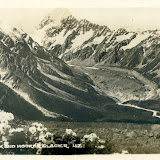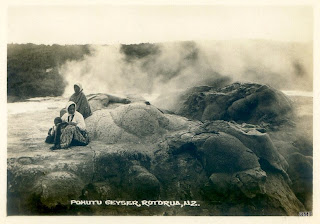"If it would not look too much like showing off, I would tell the reader where New Zealand is."
Mark Twain
Between the 1860s and the 1890s photographers working for the various US geological surveys documenting the landscape established a mythic image of America that still resonates. John Ford, Cormac McCarthy and Annie Proulx owe something to them when it comes to imagining the landscape and where we stand as mere humans in its epic sweep. Photographers of the west have never been able to shake loose of their influence. Nearly 150 years on, the template that O’Sullivan, Jackson et al provided persists; it is what America should look like. At about the same time photographers were wandering about New Zealand. In technical skill and aesthetic judgement they were the equals of the Americans yet they are barely known outside their country. It’s not hard to understand why; no one imagined the hopes and dreams of western civilization would reside in New Zealand. Still, credit where it’s due. The New Zealanders were some of the finest landscape photographers of their age and it’s possible they had no idea what was going on in America.
As countries go it’s somewhat idiosyncratic; geographically located in the South Pacific but geologically closer to Scandinavia or Japan, where active volcanoes and glaciers feed into tropical forests, mountainous fjords on one side, white palm fringed beaches on the other. It’s as though the entire European land mass was compressed into an area a little bigger than Britain. Finding routes through the mountains may have been forbidding but this wasn’t a country large enough to ‘tame’ in the sense that Americans or Australians would talk about dominating the land. And speaking of Australia, the New Zealand photographers provide some evidence of why landscape photography barely existed in that country. The written accounts of early Australian settlers don’t hold much fascination for the land. Away from the coast it quickly becomes flat, dry and wretched and they complain incessantly about the heat, the flies, sandstorms, lack of water and their primitive living conditions, none of which inspire people to think about the photogenic qualities of a place. The New Zealanders on the other hand, who didn’t have to travel far to find spectacular views, could also enter areas that reminded them of their homeland. With a little imagination they could think they were in Cheddar Gorge or the Scottish highlands.
The photographs in this post come from a small album of miniature snapshots with the inscription, “Christmas 1924/ with much love and best wishes from mother”. Two of the images can be identified as being taken by George Valentine, son of James Valentine, who emigrated to New Zealand in 1884 for his health and died six years later. As discussed in a previous post, the Valentine Company frequently printed from old plates in its extensive library, so it can be assumed all the photographs in the album were taken by George some forty years earlier. Like Alfred Burton, another British émigré working at the same time, Valentine, who already had a reputation as a landscape photographer in Scotland, saw his market in tourism and in the few years left in his life took hundreds of landscapes and ethnographic studies of the Maoris.
Photographers don’t like admitting this but the hardest job they often have in taking a landscape is finding the right point of view. Valentine belonged to that early school whose only requirements were a formalist aesthetic and a willingness to wait around for the right conditions. The landscape of New Zealand he photographed was every bit as majestic and Arcadian as the American west. In that sense he deserves to be regarded with the same respect as the Americans are.
VIEW THE GALLERY HERE
 |
| NEW ZEALAND |


























